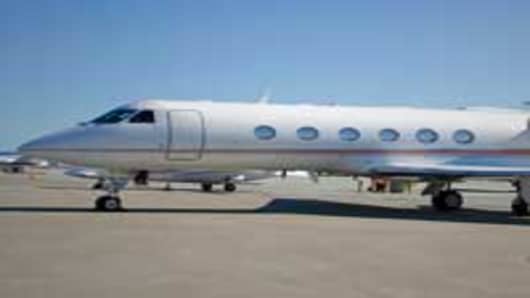Whether used for ordering food or simply getting from one place to another, private jet travel, which was shunned at the start of the recession as a sign of insensitive opulence, has begun to recover, with usage in Europe edging back towards the pre-crash levels of 2007.
This mini-recovery is welcome news for the industry’s interior designers. Those for whom money is no object are once again beginning to fill their jets with Jacuzzis, cinemas and full-service kitchens.
A midsized airplane refurbished by an internationally known designer will typically involve a fee of about $400,000, companies say. However all work is required to go through a “completion center”, as aircraft can only be worked on by certified engineers.
This can see a simple interior typically cost $1million for work and materials. For a new transcontinental-sized craft, such as the $50 million Bombardier Global 6000, the cost can be as high as $15 million.
“The private jet interior market is a very small one but we take care of each client’s particular needs,” says Bijan Khezri, managing director of TAG Aircraft Interiors. “It is a very private market – people don’t like to go screaming from the top of the roofs about what they have – but people want comfort and uniqueness.”
This need to differentiate one wealthy man’s jet from another drew numerous multinationals into luxury aircraft design in the years before the financial crisis.
BMW , Lufthansa Technik and Edése Doret have for several years lent their technical expertise to installing lighting systems, control panels and other gadgets in jets, while fashion houses such as Hermès and Versace sell jets crafted by their own designers.
The $6 million L’Hélicoptère par Hermès, a Eurocopter EC135 designed by the French fashion house, features brown calf leather seating and a white canvas cockpit, and several diamanté embossed renditions of the company’s logo inside. The first was reportedly sold to Abu Dhabi in 2009.
Elsewhere, Versace worked with the Anglo-Italian helicopter manufacturer AgustaWestland to design an aircraft using only black and white.
At the most recent Business Jet Interiors world expo, some of the latest innovations included touchscreen panels for passengers to control the lighting and cinema systems from their seats, on-board aquariums surrounded by grass, and ultra-lightweight, unbreakable glass to reduce the total load of the aircraft.
Other high-priority designs are communications systems that work effectively in the air, where a strong high-speed internet signal is still difficult to achieve. “Everyone wants the best communication in their planes, and all the companies are trying to find the best solution to that,” says Khezri. “You need to be able to communicate with everybody while you are flying and high-speed internet in the air is something where the technology is slowly getting there.”
Howard Guy of Design Q, a UK-based consultancy that specializes in tailored designs for cars, jets and boats, says: “When you get into the larger aircraft it becomes like a hotel, with dozens of staff supporting the plane based in a galley area down below. You have very comprehensive cooking facilities, and on larger aircraft we have looked at theatres, with spiral staircases and a Steinway grand piano.”
Three years ago, Design Q was given the challenge of drawing up one of the most ambitious jet designs of recent times, based on an Airbus A380 jumbo jet, normally used to seat 600 passengers.
The design, commissioned by an unnamed customer from the Middle East, included a garage at its rear, where guests could drive directly on to the jet and exit on to a red carpet. Once on board, the modified jet contains a lift to move between its three floors, a circular staircase, and a small concert hall with baby grand piano.
Elsewhere on board is a Turkish bath, specially crafted from marble thin enough not to add excessive weight to the aircraft, and a “well-being room”, where the floor contains a large screen that shows where the airplane is flying over. In the center of the jet is a boardroom featuring an outsized iTouch screen, and a projector that beams share prices on to the tables.
Unfortunately for the consultancy, the eventual bid for the airplane did not come through, with the project also struggling to find a hangar large enough to assume the risk of a project estimated to be worth £1 billion ($1.6 billion).
Yet even the wealthiest clients must accept the physical limitations that exist when cramming often heavy equipment inside an aircraft that must pass rigorous safety checks while remaining light enough to keep fuel consumption under control.
It is this less glamorous side to aircraft interior design that remains a challenge for the most adventurous companies working in the field. “What you see on the surface of a plane is really not what it costs, it is what is underneath that is the real cost – the wires and the safety devices,” says Khezri.
This also means there can be little incentive for designers of regular household products to make versions that have undergone the testing to be suitable for use inside an aircraft, with a simple DVD player for use on board costing as much as $5,000.
“The limitations for what you can put inside a plane are pretty much the limits of physics, and even money cannot always overcome that,” says Guy. “Even so, people are still always trying to push them.”


